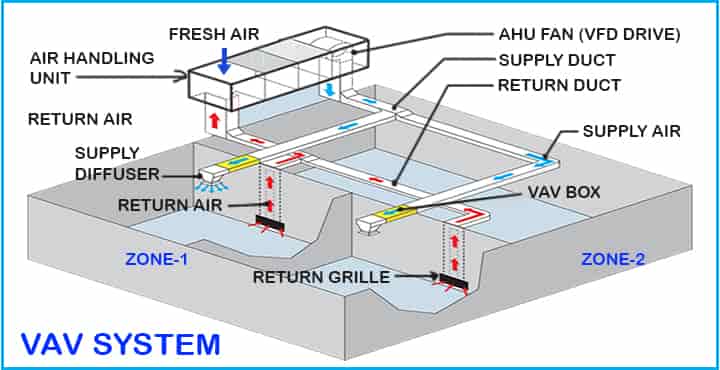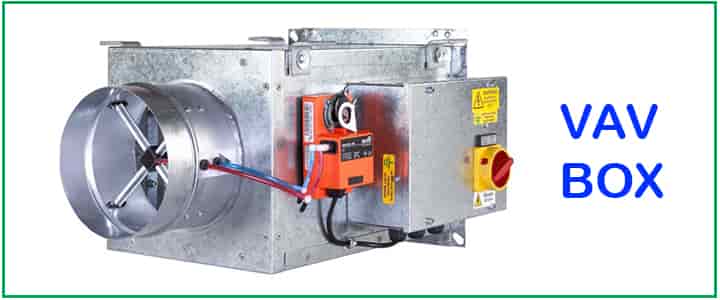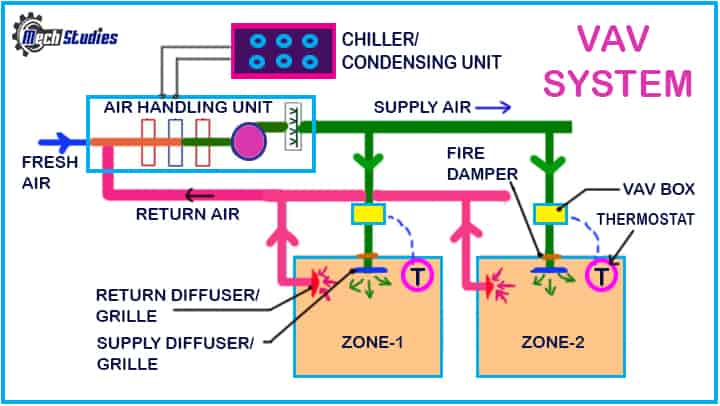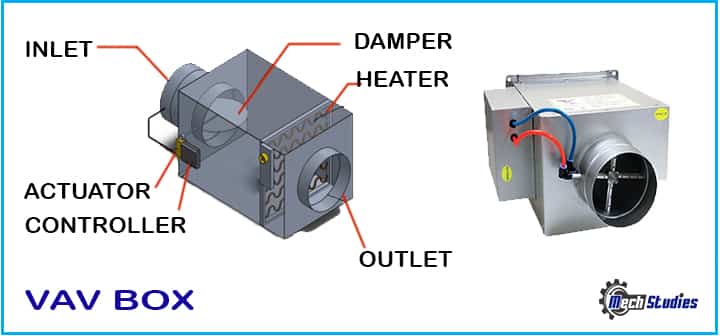Variable air volume (VAV) system in HVAC system is described along with basics, definition, associated terms, how does it work, difference between VAV & CAV system, features, calculations, advantages, disadvantages, etc. Let’s explore the Variable Air Volume in HVAC!
What is a Variable Air Volume (VAV) system? Full Form in HVAC, Definition, Meaning
Variable Air Volume (VAV) System Basics, Meaning
Let’s understand the basics of variable air volume system. Some systems provide an immense advantage to humanity. It acts as shielding and offers maximum comfort.
- One of the efficient ones that help in practical ways is the VAV system.
- Variable Air Volume system is the core advancement that is equipped with all the core advantages.
- VAV is a ventilating, air conditioning, or heating systems that provides adequate protection from changing weather conditions.
- VAV system has additional equipment called VAV boxes, which helps to work differently from CAV (constant air volume) system. We will learn all about VAV boxes as well as the system.
Though the variable air volume is the core process that entails effective functioning, the whole system helps get maximum benefit. An overview of this variable air volume entails that it is equipped with a supply duct that cools down the environment by providing supply air at any desired temperature.
- The whole phenomenon depends on the supply air temperature, in which the air flow rate is an essential aspect that helps increase or decrease heat in the thermal zone or environment.
- This excerpt is all about the VAV systems and its holistic information. This will be effective in all aspects as it helps the reader to gain all the desired information.
The first and foremost thing that holds massive importance is the core definition of this system. Let’s delve into the practical introduction of this system.
VAV System Definition
A VAV system is an effective way by which appropriate room temperature in the desired environment by a dynamic change in air quantity rather than varying or changing the temperature. A system is defined as a series of individual parts that interact and function accordingly to ensure a specific or desired design.

The VAV system mainly consists of a,
- furnace,
- thermostats,
- air handler,
- main duct,
- VAV boxes,
- diffusers,
- branch ducts and
- a chiller/condensing unit.
It also includes some of the subsidiary parts such as,
- filters,
- mixing boxes,
- fans,
- fire dampers,
- heating coils,
- duct smoke detectors, and
- cooling coils.
The above parts or pieces of machinery synchronize in a way and provide a comfortable and cozy environment. This can be attained in a specific building or any covered zone. It is vital to understand the different parts that make this VAV system an efficient one. We will provide a brief description of all the components that make the VAV system a success.
Parts or Components associated with VAV System
While understanding the VAV system concept, it is imperative to get knowledge of some essential terms. These terms will provide an easy understanding of the whole system.
VAV Boxes
This is simply a box controlled with the help of a thermostat, which regulates the air quantity. This system provides conditioned air to the desired zone or environment.

It is simply a box consisting damper, inlet, outlet, actuator, controller, heater (as applicable). Remember, the VAV box is a part of the VAV system.
Furnace
This is the equipment that helps in providing hot air in the desired zone. With this apparatus, heat can be produced, which ultimately helps provide the desired heat for the zone or produce steam.
Duct
A designated passage or a pipe of fiberglass or sheet metal through conditioned or heated air passes.
Diffusers
This equipment has numerous slats at various angles, which helps in deflecting heated or conditioned air in different directions from an outlet.
Fire Damper
This is safety equipment installed in the VAV system. The fire damper has an efficient function that provides automatic blockage to the smoke and fire if it happens. It is required in those places where the duct is in the vicinity of a fire-rated shaft, a firewall, or other fire-prone areas.
Chiller/Condensing Unit
The chiller or condensing unit is among the vital parts of the VAV system that provides a compelling advantage by providing a compressive refrigeration cycle. This helps to chill the water that helps to cool the desired zone.
Air Handler
The air handler is a set of machinery that contains different equipment, which helps the inefficient distribution of conditioned air in a specific zone. It generally comprises filters, fans, etc.
Ductwork
The ductwork comprises different parts that help in the overall process of the VAV system. Mainly it has a system of ducts, dampers, and connectors. The processes involved are air conditioning, heating, and ventilation.
Thermostat
This is among the essential parts of the VAV system that automatically performs actions to temperature change. This helps activate the switches that control all the other parts of the VAV system, such as refrigerators, furnaces, and air conditioners.
The above are some of the critical parts of the VAV system that performs different functions. Here we are also providing some of the efficient processes that are related to these parts. Moreover, this system provides thermal comfort, which is nothing but the body’s ability to release heat and moisture due to several metabolic actions.

- Hardcover Book
- Haines, Roger W. (Author)
- English (Publication Language)
- 576 Pages - 10/30/2009 (Publication Date) - McGraw Hill (Publisher)
Parameters for VAV System in HVAC
Different processes constitute thermal comfort; some of them are as follows:
Humidity
A place that is closed and doesn’t have any openings needs an effective VAV system. These areas experience massive surges of humidity, which can be lethal. Places like conference halls, auditoriums, etc., need a VAV system to eliminate the humidity. The VAV system performs this action by releasing air into that area.
Heating
Heating is the core function of a furnace that is present in the VAV system. Specifically, there are heating coils that are located in the ducts which provide effective heating.
Cooling action
Thermal comfort has a fair share of the cooling aspect, and the VAV system distributes it according to the demand. This cold air can be preheated to maintain the desired ventilation requirements.
Temperature
The volume of air delivered to the zone at a set temperature helps in controlling the temperature of the zone. When it comes to the mechanism, the volume of air distributed by the VAV boxes is controlled by a thermostat located in the zone.
Pressure
VAV systems are also capable of depressurizing as different areas need to be depressurized to provide sufficient thermal comfort. The VAV system provides effective measures by providing a dynamic approach to the volume of air, which helps in those places that are not equipped with appropriate pressurization requirements. Understanding these core processes makes it relatively easy to grab a fair share of knowledge about VAV systems further. One will get hands-on help in understanding the overall concept with this.
How Does a VAV System Work?
Let’s try to understand how does VAV system work. The main feature of the VAV system is it allows the zoning of buildings. Suppose a building has two rooms,
- Room-1 needs 22 deg. C
- Room-2 needs 24 deg. C
Now, if we consider a CAV system, we cannot maintain three different temperatures in different areas but if we consider a VAV system, it can be possible.

The main difference between a CAV & VAV system is that an additional VAV box or VAV terminals are included in the VAV system. Let’s try to understand the main working philosophy.
- AHU is connected to the rooms through the ducts, diffusers, volume control dampers, fire dampers, etc.
- Now, two rooms need to be maintained at two different temperatures, due to different heat loads or different temperature requirements.
- AHU unit supplies the cool air to the rooms through the supply duct and cools it and picks the heat of the room. This air is called supply air.
- After heat picks up, the air is becoming hot slightly (approx. 2 deg. C above supply air temperature) and returns back to AHU through the return duct. This air is called return air.
- Fresh air is introduced in the return duct or AHU itself and mixed to meet the fresh air requirements of the conditioned areas.
- This fresh air and return air is mixed in the AHU mixing chamber and cooled through a cooling coil. After that, it circulates through a blower to the rooms.
- As two different temperatures to be maintained, a normal CAV system cannot, hence, a small box called a VAV box is introduced. Due to this VAV box, this system is called the VAV system.
- AHU delivers air at 12 deg. C and we need to maintain 22 and 24 deg. C.
- VAV box or VAV terminal is kept on the branch duct which is coming from the main branch duct.
- Here, we have considered two different rooms, however, VAV can consider many rooms or many groups of rooms at different requirements.
Now, let’s see how the VAV box works in the system.

- VAV box has an inlet damper which is controlled by an actuator as well as the controller. With the help of a controller, an actuator can close or open or control the damper opening.
- The thermostat is connected to the VAV box with a control cable and the thermostat is placed inside the conditioned room.
- The thermostat helps to set the temperature and in case temperature changes with respect to the set temperature, it immediately signals to the controller, and the controller signals to the actuator to control the damper’s opening.
- If the room temperature is more than the set temperature, the damper opening will be increased to increase the cooling airflow rate, and if the temperature low than the set temperature, heater which is present in the VAV box will start to operate to meet the temperature requirements. In many systems, to heat the air, a separate duct heater is used.
- This control is done by PLC based microprocessor or direct digital control system nowadays.
- In an advanced system, the AHU fan is considered VFD driven. In a VAV system, if any area requires less air then it will be bypassed to the main duct and it will increase the pressure of the duct as well as the whole system. The pressure sensor is installed in the duct.
- VFD system helps to avert this problem, as the pressure sensor gives a signal to the AHU fan to change the speed as well as the capacity of the fan.
- If pressure falls, fan speed will be more, and if pressure increases, fan speed will be lowered.
Check a very nice video from The Engineering Mindset,
Let’s see the basic differences between the CAV system and the VAV system.
Difference Between CAV system & VAV system
The difference between the CAV system and the VAV system, are as follows,
| CAV System | VAV System |
| CAV system stands for constant air volume system, which means the air supply is constant with different temperatures. | VAV system means air flow rate will be different at a constant temperature. |
| It can use for the single zone as well as multi-zones, however, efficiency is more in case of a single zone. | It can use for the single zone as well as multi-zones, however, efficiency is more in case of multi-zones. |
| System efficiency for multi-zone is less | System efficiency for multi-zone is high |
| In case of multi-zones, zone wise heater needs to be considered and it reduces efficiency | In case of multi-zones, VAV boxes are used to control the temperature. In case, heating is required, the same shall be served by the heating element in the VAV box. |
| Normally, where load variation is less, the CAV system is preferable. Like, industrial buildings, control buildings, etc. | Normally, where load variation is more, the VAV system is preferred. Like, malls, concerts, hotels, etc. |
Features of a VAV system
There are some of the specific features that define the overall benefits of this system. Following are some of the efficient ones that help humankind in the best possible ways.
- When it comes to controlling these VAV systems, it is quite easy as the whole VAV system is equipped with a communication system that provides an optimal guarantee. The control strategy of the VAV system is an addition to the benefits.
- The inclusion of advanced optimization and low volume airflow sensors provides both ranges of meter air from maximum to minimum that help air environmental comfort.
- VAV system is equipped with low noise actuators, an integrated air valve DC motor, which provides practical and increased environmental comfort.
- VAV is equipped with precise temperature comfort control and some of the optimal parameters of air quality control. These are capable of attaining maximum comfort and energy saving.
- The best feature of VAV systems is that it works on the demand control strategy that helps to attain minimum energy consumption. The overall mechanism of this system helps in fulfilling the LEED certification fulfilment.
- This system can easily be upgraded as it has optimal support, which comes with different additional attributes. In this system, you don’t have to replace the internal chip. It is also equipped with improved upgrades and efficient repair service.
VAV System Calculation Example
Let’s consider two rooms that have been provided with a VAV system. This example is just to illustrate the VAV system basics only. The room has a heat load of 50.0 kW and it needs to be maintained at 22 oC temperature to be maintained. Outside design temperature is 45 deg. C. Let’s try to understand the system.
q = Cp X ρ X Q X dt
where
- dt = 45-22 = 23 oC (temperature difference for Room, oC)
- q = 50.0 kW (sensible heat for Room to be conditioned, kW)
- ρ = 1.202 kg/m3 (air density, kg/m3)
- cp =1.006 kJ/kg oC (specific heat of air
 , kJ/kg oC)
, kJ/kg oC) - Q = ?, air volume flow for Room, m3/s
q = Cp X ρ X Q X dt
Q = q / (Cp X ρ X dt )
Hence, we get,
- Q = 50.0 ÷ (1.006 x 1.202 x 23)
- Q = 1.77 m3/s = 1770 lps (liter per second)
Now, the VAV system will adjust normally this 1770 lps air quantity. Let’s check how the VAV system works if the load changes say in the summer season it is increased to 60 kW and in the winter season it is reduced to 40 kW.
Option-1: Heat Load Increased to 60 kW
Air quantity, Q1
- Q1 = q1 / (Cp X ρ X dt )
- Q1 = 60 / (1.006 x 1.202 x 23) [Temperature difference is fixed]
- Q1 = 2.15 m3/s = 2150 lps
Here, the temperature difference is constant and the VAV system, as well as the VAV terminal, increases the air quantity by increasing the damper opening area and maintaining the required air quantity of 2150 lps.
Option-2: Heat Load Decreased to 40 kW
Air quantity, Q2
- Q2 = q2 / (Cp X ρ X dt )
- Q2 = 40 / (1.006 x 1.202 x 23) [Temperature difference is fixed]
- Q2 = 1.44 m3/s = 1440 lps
Here, the temperature difference is constant and the VAV system, as well as the VAV terminal, decreases the air quantity by decreasing the damper opening area and maintaining the required air quantity 1440 lps, and saving energy.
VAV System Advantages and Disadvantages
Pros of a VAV system: Advantages
The benefits of the VAV system make it quite efficient and provide all-around help for desired areas. Here we are providing some of the core benefits:
- This system is capable of providing a mere margin of error. Temperature can easily be set at a specific point without any faults. With this system, it is quite easy to maintain the temperature within 1degree of the difference.
- It helps in attaining maximum efficiency of the whole HVAC system. With this system, you can easily control a specific zone.
- The operational cost to run this system is comparatively low to the other ones.
- It requires minimal maintenance; however, different parts need to be cleaned at a specific interval.
Cons of VAV System: Disadvantages
- This VAV system’s main backdrop is the latent heat that comes in large areas such as auditoriums and conference rooms.
- This system requires a minimum amount of air. It is quite hard to set up this system where there is a lack of air requirements.
- The VAV system effectively decreases the air volume, leading to the below-par dispersion of the tempered air. Here the diffusers are capable of providing useful functions to larger areas. To cater to this problem, it is essential to use it in a zone that has a larger volume.
- The problem of below-par control on pressurization persists in this system.
- Noise pollution is the foremost problem in the VAV system, which is installed above the ceiling.
Attributes to Consider while Selecting or Installing VAV Systems
The simplistic design of the VAV system
While installing a VAV system, it is recommended to consider this attribute as the foremost fault that comes in the VAV system is the complexity.
- People try to implement complicated designs while installing this system, which causes different problems regarding maintenance and operation.
- The design of the VAV system doesn’t compromise with features and requires low maintenance.
Coordination while implementation
Implementation at the initial stage for any system is vital and complicated. Sometimes it is quite hard to attain proper communication.
- This also leads to the simplistic approach of the design.
- The early stages of designing should be researched effectively as per the zone or environment.
Climatic conditions
The VAV system is among those systems that are effective in critical climatic conditions.
- For this, it is quite vital to get all-around information about the climatic conditions of the zone and the surrounding environment.
- Humidity, pressure, temperature, and other attributes should be considered without fail.
Dos and Don’ts While Installing VAV system
It is quite essential to consider numerous factors while installing the VAV systems, as there are numerous delicate pieces of equipment. In addition to that, attaining optimal efficiency is vital; it can only be achieved by proper installation.
- It is recommended not to oversize the VAV system. Most of the time, people try to install safety factors as per load calculations. It is essential to understand that the calculation methods are already equipped with all the safety factors. This handicaps the whole system as the performance of the VAV system deteriorates.
- This system should be installed by emphasizing diversity. While installing, it is quite vital to spread the load and diversity through the supply ducts and all the ductwork.
- It is crucial to specify and design the VAV systems for both part and peak load. There should be different considerations that should be followed while submitting design calculations. These design considerations include psychometric performance. The calculations regarding normal peak load, minimum cooling load, and maximum cooling load should be appropriate.
- Keep a check on these systems as while installation, it is essential to consider ease of maintenance and flexibility of the system.
- The VAV terminal block should be considered while keeping a check on maximum and minimum flows. The overall schedule should define the cfm, pressure drop, neck velocity, and noise criteria. These attributes help in the proper maintenance of the system.
- The ductwork design should be attained using one of the efficient methods, such as the static regain method. It is recommended to use computerized ductwork design analysis, which is a proven method. This method helps in keeping the static pressure constant. With this, one can easily establish the stability of the system.
Applications of VAV System
The versatility of the VAV system is its forte. The common usage of this system is in large to medium office buildings. Apart from these, it is also used in,
- apartments,
- stores,
- exhibition halls,
- auditoriums,
- theaters,
- factories,
- hotels,
- hospitals,
- dorms,
- labs,
- motels,
- libraries,
- arenas,
- nursing facilities,
- schools,
- shopping centers, and
- many other massive buildings.
Some of the core usages of this system are in hospitals and nursing facilities, as these facilities need a specific level of pressurization that can be achieved with this system. However, this attribute can be cumbersome as it is difficult to maintain a specific pressure in any zone.
It can also be used in large offices as this system helps in achieving maximum efficiency of the HVAC system. The customized control of the environment makes it quite apt for usage. One should use this system as there can be problems with latent heat loads when used in massive auditoriums. The major problem that occurs is sound pollution if the equipment is located on the ceiling.
FAQs on Variable Air Volume or VAV
What is difference of CAV and VAV?
CAV system stands for constant air volume system, which means the air supply is constant with different temperatures. On the other hand, VAV system means air flow rate will be different at a constant temperature.
CAV System efficiency for multi-zone is less, however, CAV System efficiency for multi-zone is high.
Summary
The all-round analysis of the VAV system provides all the information. Being one of the most advanced and proven temperature modulation systems, one can get optimal benefits. With this information, you will get a holistic view of the different terms associated with VAV systems.
In addition to that, the applications of this system help to use vividly. The advantages and disadvantages are the foremost information that holds the crux of the system. This genre of dynamic temperature modulator system has a bulk load of information. The VAV system has wide applications, and that needs further elaborative analysis. Any questions?


